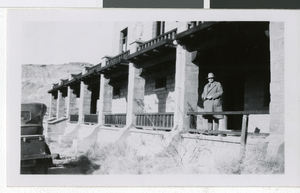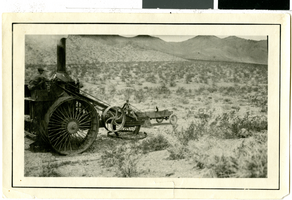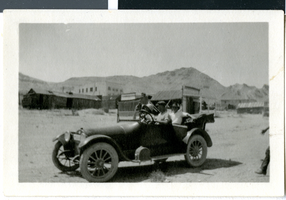Search the Special Collections and Archives Portal
Search Results
Bank ruins, Rhyolite, Nevada, 1948 November 25
Level of Description
File
Archival Collection
Anita Freeman Photograph Collection on Southern Nevada
To request this item in person:
Collection Number: PH-00245
Collection Name: Anita Freeman Photograph Collection on Southern Nevada
Box/Folder: Box SH-029
Collection Name: Anita Freeman Photograph Collection on Southern Nevada
Box/Folder: Box SH-029
Archival Component
Bottle house, Rhyolite, Nevada, 1948 November 25
Level of Description
File
Archival Collection
Anita Freeman Photograph Collection on Southern Nevada
To request this item in person:
Collection Number: PH-00245
Collection Name: Anita Freeman Photograph Collection on Southern Nevada
Box/Folder: Box SH-029
Collection Name: Anita Freeman Photograph Collection on Southern Nevada
Box/Folder: Box SH-029
Archival Component
"Memorial for Queer Rhyolite" project webpage: archived website, 2021
Level of Description
Other Level
Archival Collection
<em render="italic">Memorial for Queer Rhyolite</em> Papers
To request this item in person:
Collection Number: MS-01067
Collection Name: Memorial for Queer Rhyolite Papers
Box/Folder: N/A
Collection Name: Memorial for Queer Rhyolite Papers
Box/Folder: N/A
Archival Component
Building located in Rhyolite, Nevada, approximately 1910-1929
Level of Description
File
Archival Collection
L. F. Manis Photograph Collection
To request this item in person:
Collection Number: PH-00100
Collection Name: L. F. Manis Photograph Collection
Box/Folder: Box 06
Collection Name: L. F. Manis Photograph Collection
Box/Folder: Box 06
Archival Component
Bottle House in Rhyolite, Nevada, approximately 1900-1920
Level of Description
File
Archival Collection
L. F. Manis Photograph Collection
To request this item in person:
Collection Number: PH-00100
Collection Name: L. F. Manis Photograph Collection
Box/Folder: Box 06
Collection Name: L. F. Manis Photograph Collection
Box/Folder: Box 06
Archival Component
Bottle House in Rhyolite, Nevada, approximately 1900-1920
Level of Description
File
Archival Collection
L. F. Manis Photograph Collection
To request this item in person:
Collection Number: PH-00100
Collection Name: L. F. Manis Photograph Collection
Box/Folder: Box 06
Collection Name: L. F. Manis Photograph Collection
Box/Folder: Box 06
Archival Component
Heisler, H. H. and residents of Rhyolite, Nevada, 1969 April 17
Level of Description
File
Archival Collection
Frank Mitrani Photographs
To request this item in person:
Collection Number: PH-00332
Collection Name: Frank Mitrani Photographs
Box/Folder: Box 21
Collection Name: Frank Mitrani Photographs
Box/Folder: Box 21
Archival Component

Photograph of Frank Garside posing in front of the Rhyolite Depot, Las Vegas, circa 1920s
Date
1920 to 1929
Archival Collection
Description
Frank Garside standing on the porch of the Rhyolite Depot in Las Vegas.
Image

Photograph of J. Irving Crowell on "Old Dinah" machine near Rhyolite (Nev.), circa 1925
Date
1924 to 1926
Archival Collection
Description
J. Irving Crowell sitting on top of a machine called "Old Dinah" somewhere south of Rhyolite.
Image

Photograph of Mr. Corwell, Mrs. Corwell, and friend in a car, Rhyolite (Nev.), circa 1925
Date
1924 to 1926
Archival Collection
Description
Mr. Corwell, Mrs. Corwell, and friend sitting in an automobile in Rhyolite, Nevada.
Image
Pagination
Refine my results
Content Type
Creator or Contributor
Subject
Archival Collection
Digital Project
Resource Type
Year
Material Type
Place
Language
Records Classification
